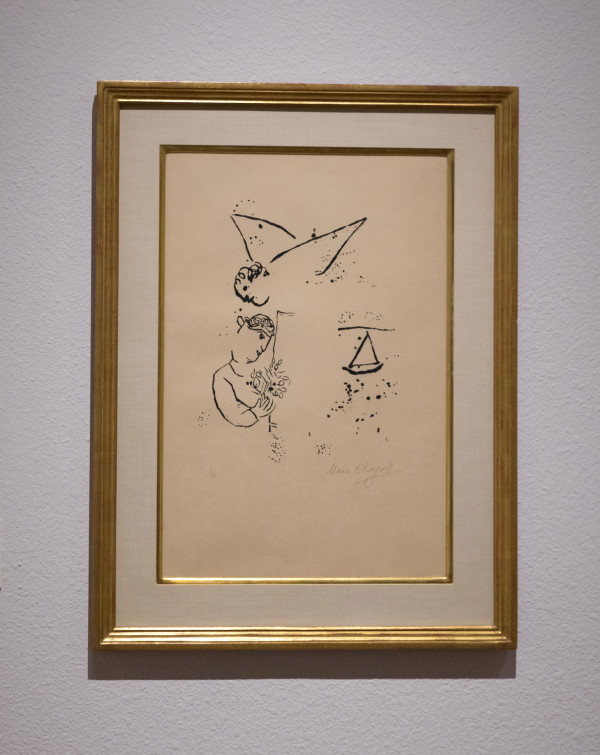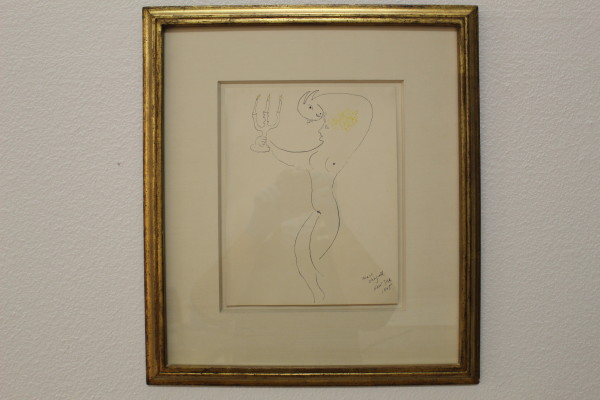
UNLV Marjorie Barrick Museum of Art
Las Vegas, Nevada
We believe everyone deserves access to art that challenges our understanding of the present and inspires us to create a future that makes space for us all.
Message-
Artist: Marc Chagall
Marc Chagall was born Moishe Shagal to an Orthodox Jewish family on July 7, 1887 in Liozna, near the city of Vitebsk, in Belarus, which was then part of the Russian Empire. Chagall was an early modernist who explored childhood memories of his life in Russia and his Jewish identity through his figurative and narrative works which have a dreamlike, almost supernatural quality to them. He blended elements of surrealism, cubism, and fauvism, creating his own style. The art critic Robert Hughes (1938-2012) called Chagall “the quintessential Jewish artist of the twentieth century.”
Chagall was the oldest of nine children. His father, Khatski Shagal, worked at a herring factory. His mother, Feige-lte, sold groceries out of their home. As a child, he drew pictures on grocery sacks that hung over his bed, which his sisters stole and used as doormats. In 1906, he attended art classes taught by the portrait artist Yehuda Pen, but had no interest in traditional drawing techniques, so he quit after only two months. After being rejected by a technical drawing academy in Saint Petersburg, he was accepted into an art school where he realized that classical art and realism were not for him. In 1910, the Russian-Jewish painter and set designer Léon Bakst took notice of his talent and sponsored him to go to Paris. Bakst encouraged Chagall to include Jewish imagery in his works, in defiance of the Russian Empire’s anti-Semitism.
During his three-year stay in Paris, he made hundreds of paintings. He met French surrealists, German expressionists, and avant-garde poets who became his circle of friends. The young artist gained inspiration from them, borrowing from many of their styles, although he, himself, did not prescribe to any particular art movement. In 1915 he held his first solo exhibition in Berlin, but yearned for his home. Just before World War I he returned to Vitebsk and married Bella Rosenfeld, whom he had encountered in the middle of the street four years earlier. She was his one and only muse from that moment on.
At the start of the Russian Revolution (1917-1923), Chagall became Commissioner of Art in Vitebsk. He decorated the homes in his town with painted murals and banners depicting goats and cows, celebrating a new era for his people. He eventually moved to Moscow with Bella and their four-year old daughter, Ida, to decorate the Jewish Chamber Theater. He briefly taught drawing at an international school for war orphans before returning to Paris, a city that he often referred to as his second Vitebsk. But wherever he lived, Vitebsk was always close to his heart. The herrings, goats, fiddlers, and merchants from his childhood village were often featured in his paintings.
After Bella died in 1944 the grief-stricken painter was unable to pick up a paintbrush for a whole year, although he continued to design costume and theatre sets. In 1947 he moved to France, where he resided until his own death forty years later. In 1952 he married his second wife, Valentina Brodsky.
Throughout his life he worked in a variety of formats, including paintings, ceramics, tapestries, stained glass, book illustrations, sculpture and inlay. He also wrote essays and poetry. He traveled widely, creating stained glass windows and murals for churches and synagogues in countries like Great Britain, Germany, and Switzerland. In 1960, he made a stained-glass window for the Hadassah University Medical Center in Jerusalem. In 1964 he designed the “Peace Window” for the United Nations Headquarters in New York. His works have been seen around the world, with significant exhibitions in the United States, France, Russia, and Japan.
Chagall died on March 28, 1985 at the age of ninety-seven. He was buried in the town of Saint-Paul in southeastern France. This Belarusian-French artist was the last survivor of the early European modernists.
(Written by Michael Freborg)

